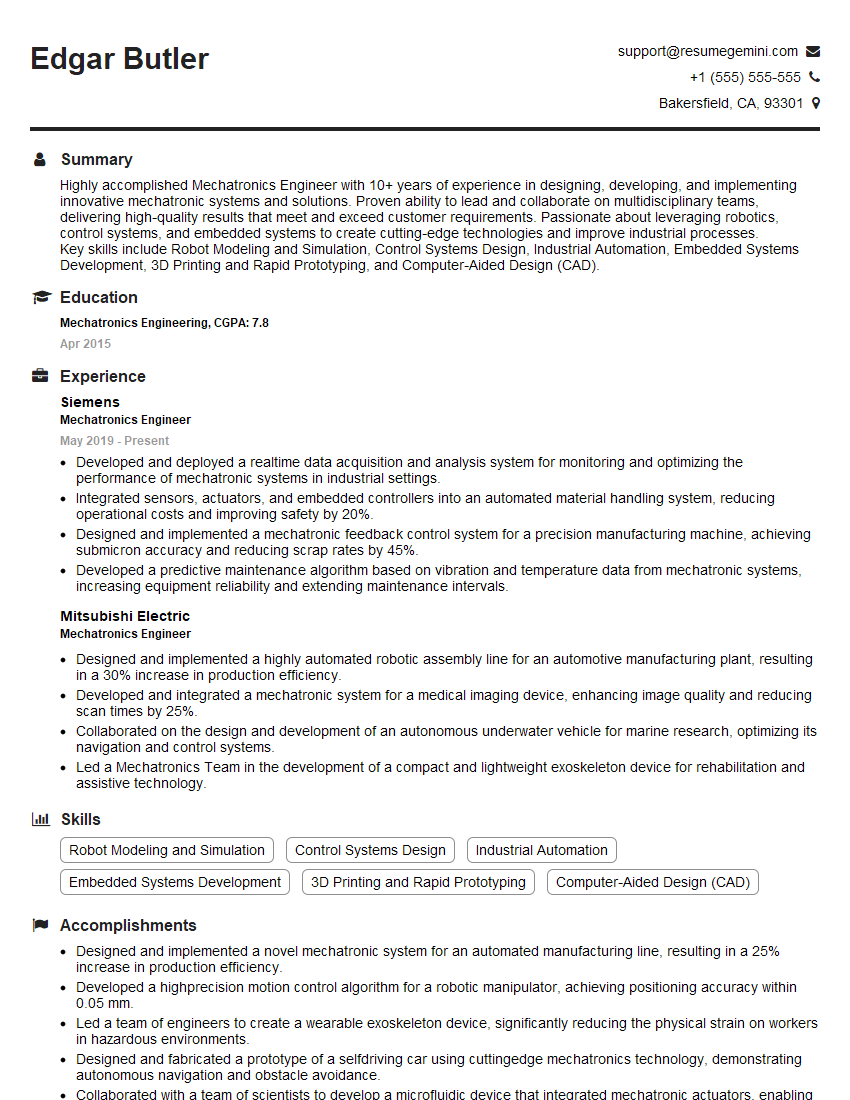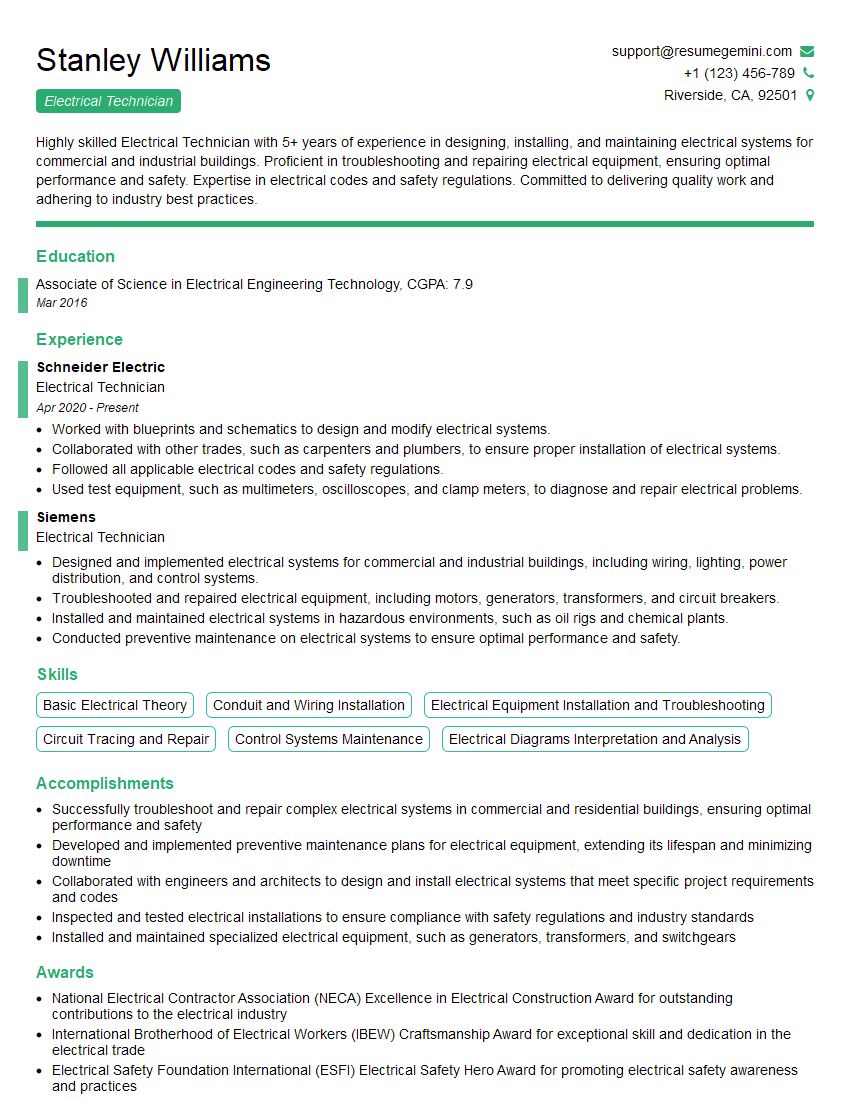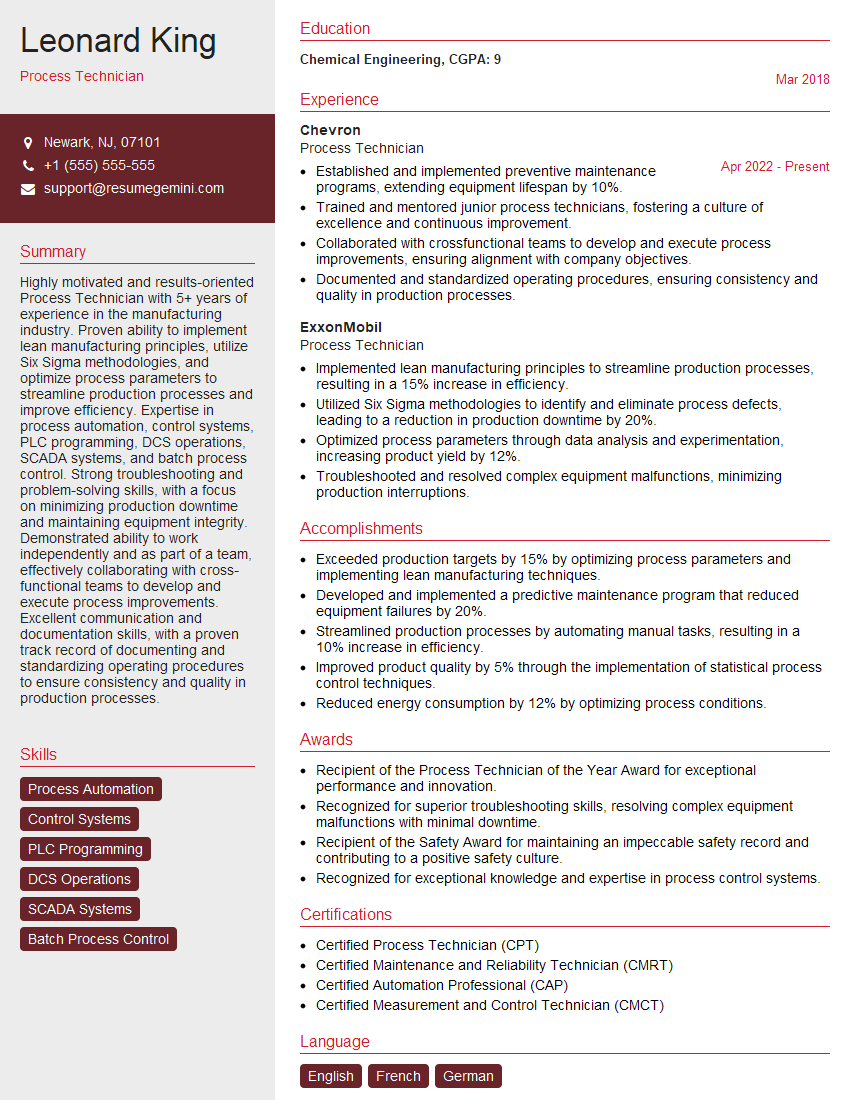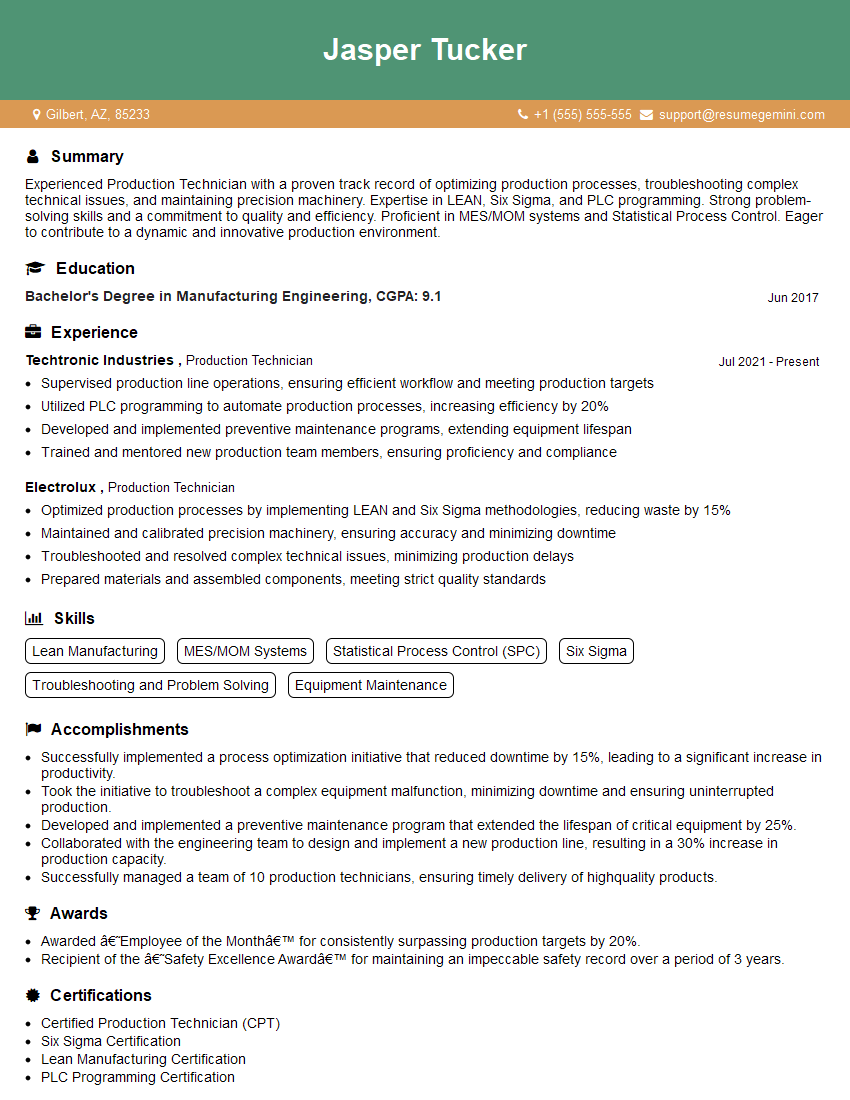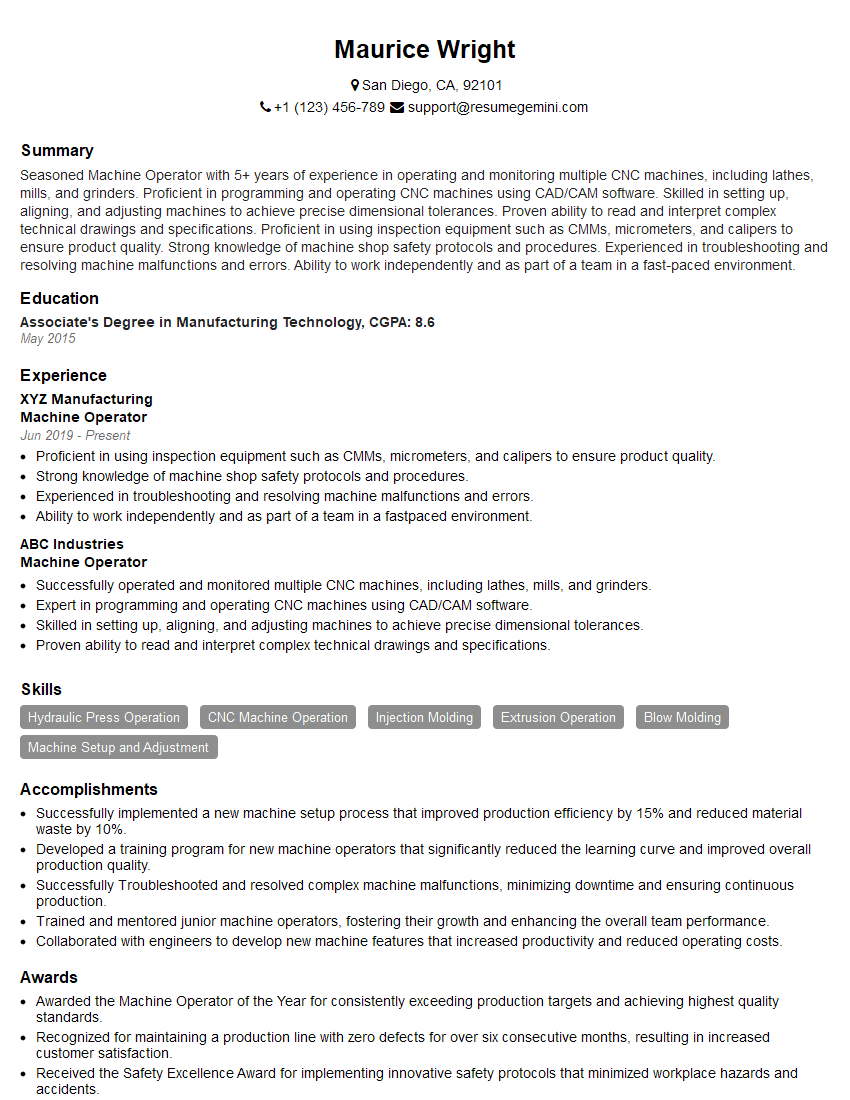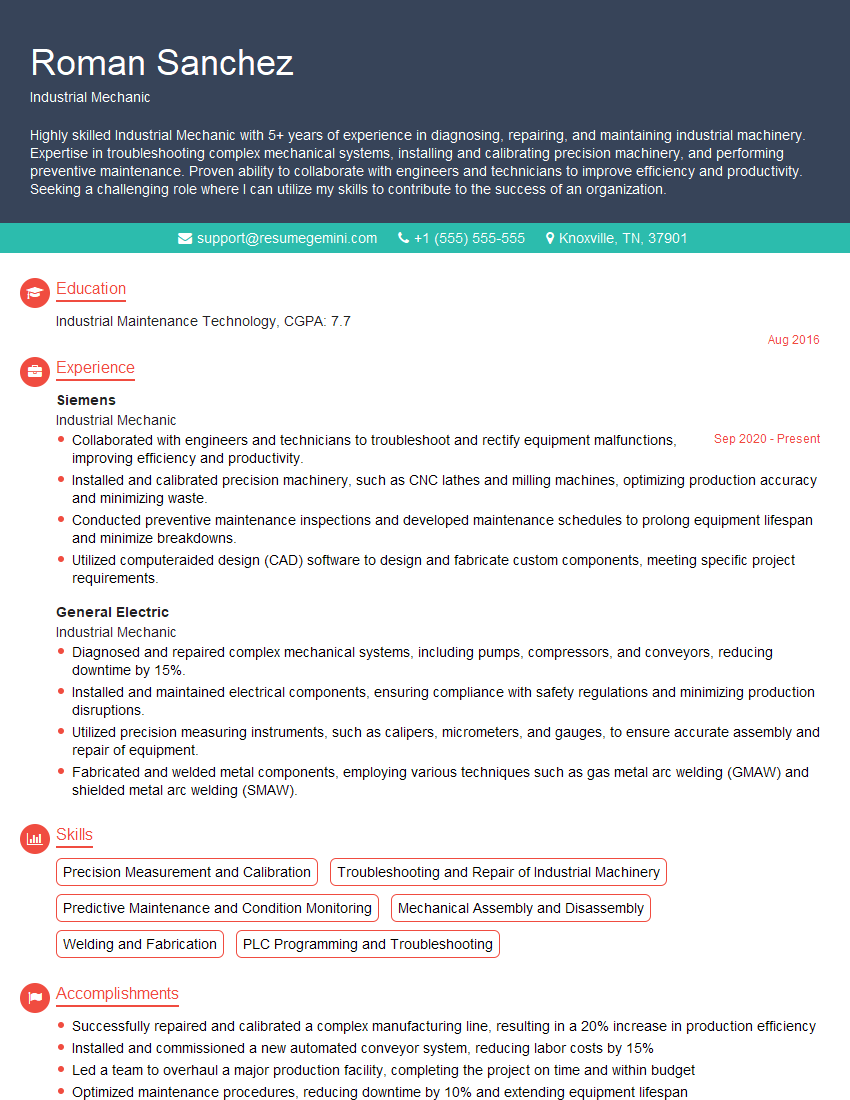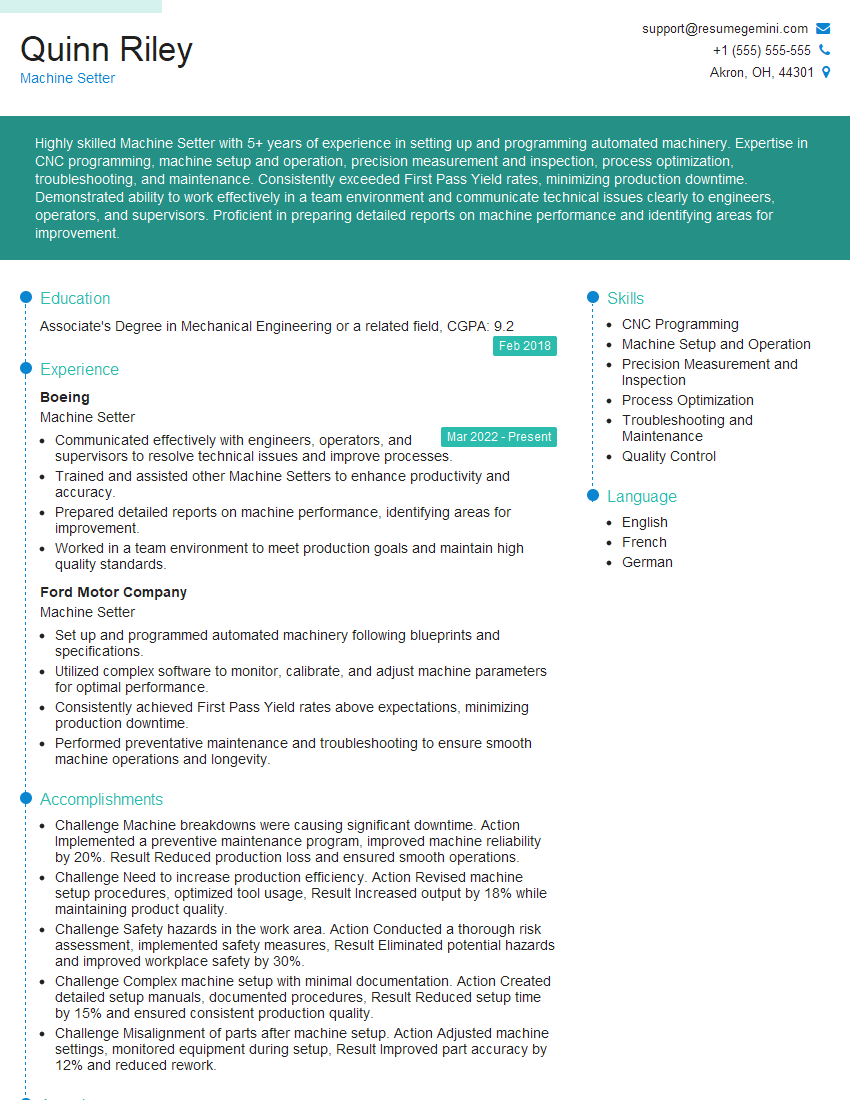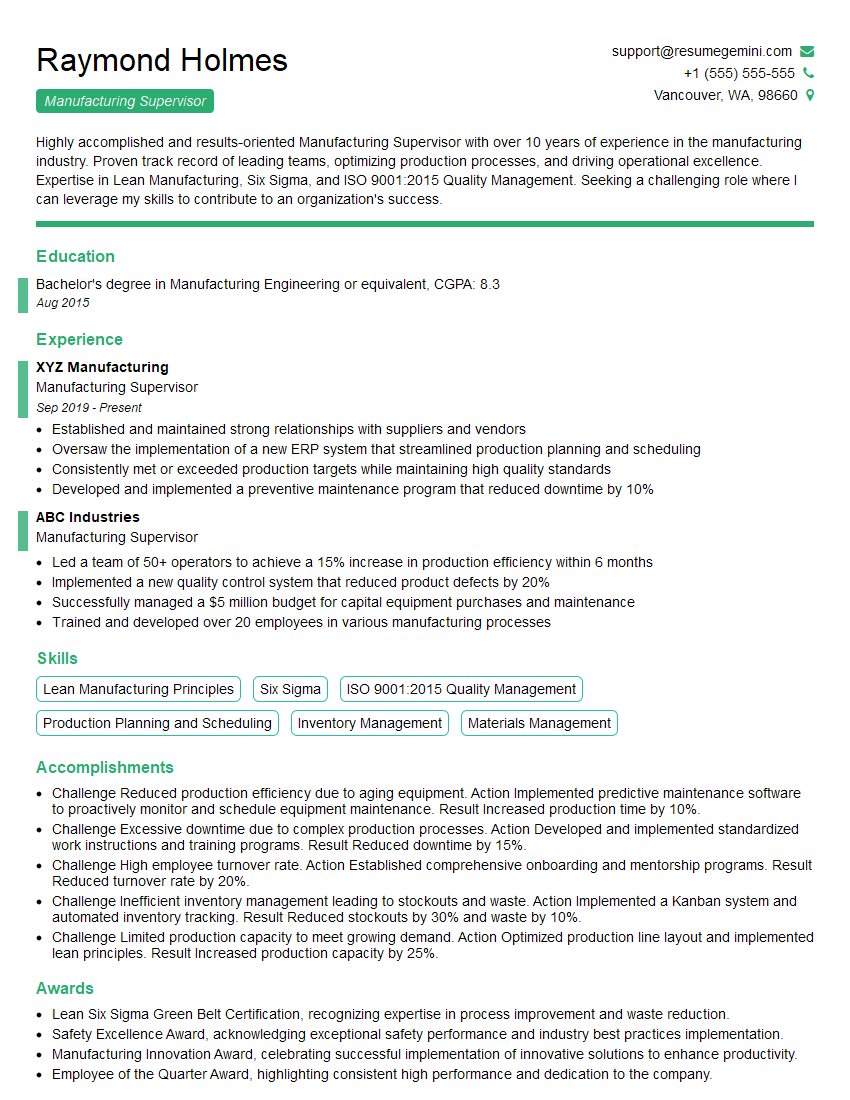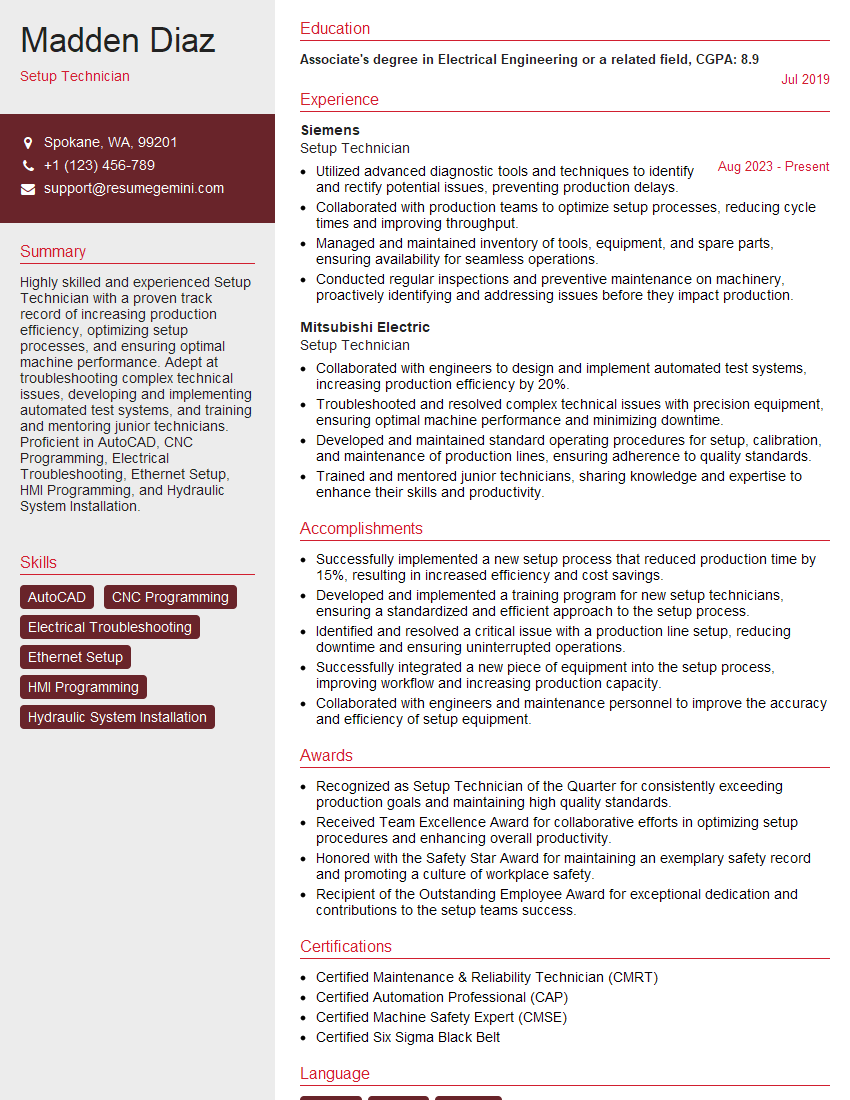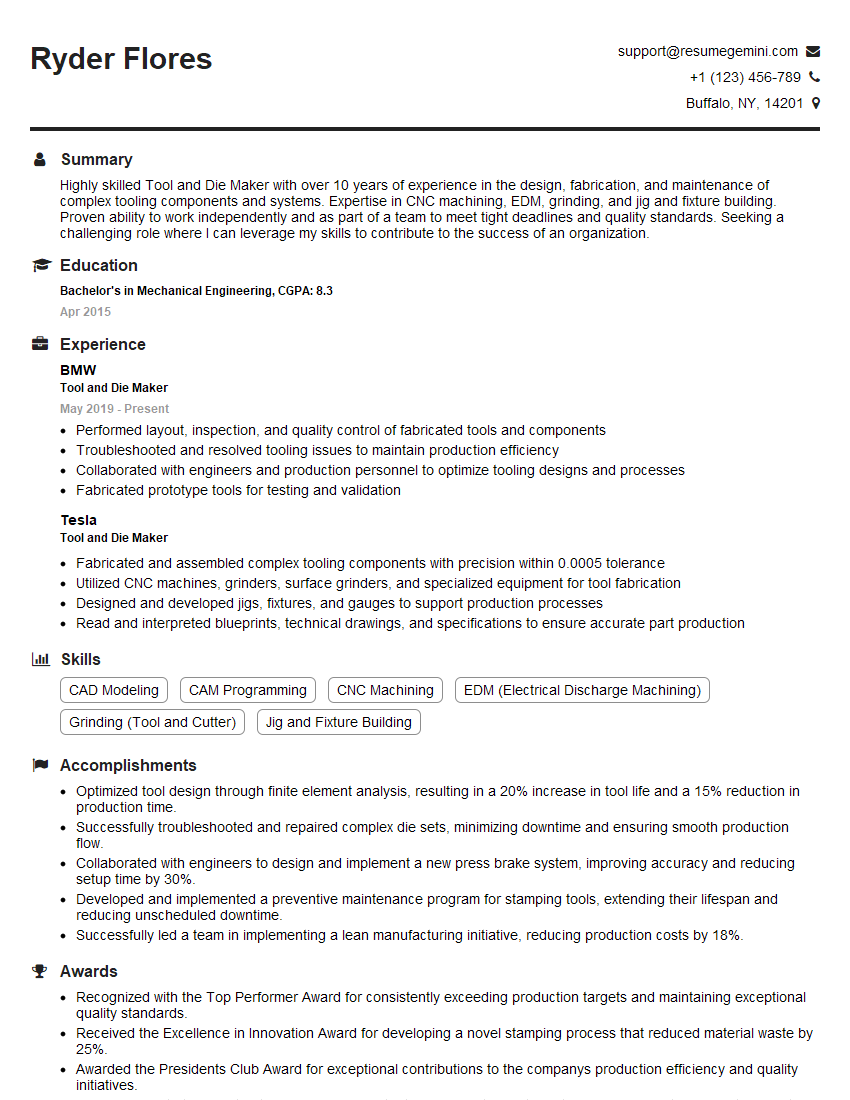Cracking a skill-specific interview, like one for Monitoring and adjusting machine settings, requires understanding the nuances of the role. In this blog, we present the questions you’re most likely to encounter, along with insights into how to answer them effectively. Let’s ensure you’re ready to make a strong impression.
Questions Asked in Monitoring and adjusting machine settings Interview
Q 1. Explain the process of setting up a new machine according to manufacturer specifications.
Setting up a new machine involves meticulous adherence to the manufacturer’s specifications to ensure optimal performance and longevity. This process typically begins with a thorough review of the provided documentation, including installation manuals, wiring diagrams, and safety guidelines.
- Unpacking and Inspection: Carefully unpack the machine, noting any visible damage. Compare the received components against the packing list.
- Site Preparation: Ensure the installation location meets the manufacturer’s requirements regarding space, power supply (voltage, amperage, and phase), environmental conditions (temperature, humidity), and grounding.
- Assembly: Follow the manufacturer’s instructions precisely for assembling the machine. This may involve connecting various components, installing software, and configuring settings. Pay close attention to torque specifications for bolts and screws to prevent damage.
- Power-Up and Initial Checks: After assembly, connect the power supply and turn the machine on. Carefully monitor the initial startup sequence, checking for any error messages or unusual behavior. This is often accompanied by a test run to validate basic functionality.
- Calibration and Fine-Tuning: Many machines require calibration to ensure accurate operation. This may involve using specialized tools and following specific procedures outlined in the documentation. Fine-tuning involves making small adjustments to optimize machine parameters based on initial performance observation.
- Documentation: Maintain detailed records of the installation process, including date, time, and any deviations from the standard procedure.
For example, in setting up a CNC milling machine, I’d carefully align the axes, verify the spindle’s rotational speed, and perform a test cut using a sample piece of material to validate accuracy before beginning full-scale production. Any deviation from the manufacturer’s specifications would be thoroughly documented and investigated.
Q 2. Describe your experience monitoring machine performance using key performance indicators (KPIs).
Monitoring machine performance using KPIs is crucial for maintaining efficiency and identifying potential issues. My experience involves selecting relevant KPIs, establishing baseline performance, and continuously monitoring against these benchmarks. I typically use data visualization tools to track KPIs like:
- Overall Equipment Effectiveness (OEE): This comprehensive KPI combines availability, performance, and quality rate to give a holistic view of machine efficiency.
- Mean Time Between Failures (MTBF): This KPI indicates the reliability of the machine, measuring the average time between breakdowns.
- Mean Time To Repair (MTTR): This KPI measures the efficiency of the maintenance process, tracking the time taken to repair a failed machine.
- Cycle Time: This KPI measures the time required to complete a single production cycle. Reduction in cycle time generally indicates improved efficiency.
- Defect Rate: This KPI tracks the percentage of defective products produced by the machine, indicating quality control issues.
I utilize data logging systems and software to collect and analyze these KPIs in real-time and generate reports. For instance, I might use a Supervisory Control and Data Acquisition (SCADA) system to monitor a production line, visualizing real-time KPIs on a dashboard. Significant deviations from established baselines trigger immediate investigation and corrective actions.
Q 3. How do you identify and troubleshoot common machine malfunctions?
Identifying and troubleshooting machine malfunctions involves a systematic approach combining observation, diagnostic tools, and expertise. The process typically begins with carefully observing the machine’s behavior, looking for symptoms such as unusual sounds, vibrations, error messages, or changes in output quality.
- Visual Inspection: Check for visible signs of damage, such as loose connections, worn parts, or leaks.
- Diagnostic Tools: Utilize specialized tools such as multimeters, oscilloscopes, and pressure gauges to measure key parameters and identify the root cause of the malfunction.
- Error Codes and Logs: Examine error codes displayed on the machine and analyze data logs to pinpoint specific problems. These often provide valuable clues about the nature and location of the failure.
- Process of Elimination: If the problem isn’t immediately obvious, systematically check each component to eliminate possible causes. This may involve isolating sections of the machine or replacing suspect parts.
- Manufacturer Documentation: Consult the machine’s troubleshooting guide or contact the manufacturer for technical assistance.
For example, if a packaging machine repeatedly jams, I might initially check for obstructions in the feed mechanism. If that’s not the problem, I’d move on to inspect sensors, motors, and timing belts using a multimeter to test voltage and continuity. Keeping detailed notes throughout the troubleshooting process is key.
Q 4. What methods do you use to optimize machine settings for maximum efficiency?
Optimizing machine settings for maximum efficiency involves a combination of data analysis, experimentation, and knowledge of the machine’s capabilities. My approach involves systematically adjusting various parameters, such as speed, feed rate, pressure, and temperature, to observe their impact on output and efficiency.
- Data-Driven Approach: I collect data on various machine parameters and their corresponding output to understand the relationships between them. This often involves running experiments with different settings.
- Statistical Methods: Techniques like Design of Experiments (DOE) can be employed to efficiently explore the parameter space and identify the optimal settings. This helps avoid unnecessary experimentation.
- Simulation: For complex machines, simulation software can be used to predict the effects of different settings before implementing them in the physical machine. This minimizes downtime and potential damage.
- Feedback Loops: Implementing feedback loops allows for automatic adjustments based on real-time performance data. This maintains optimal settings even under fluctuating conditions.
For instance, while optimizing a injection molding machine, I might systematically vary the injection pressure, melt temperature, and holding time, recording the resulting cycle time, defect rate, and part dimensions. Statistical analysis of the collected data helps identify the optimal setting combination maximizing output while minimizing defects.
Q 5. Describe your experience with preventative maintenance of machines.
Preventative maintenance is crucial for extending machine lifespan and preventing costly downtime. My experience in preventative maintenance involves a combination of scheduled inspections, lubrication, and component replacements according to a well-defined schedule.
- Scheduled Inspections: Regular inspections help identify potential problems before they lead to failures. This involves visually inspecting components for wear and tear, checking fluid levels, and listening for unusual sounds.
- Lubrication: Proper lubrication is essential for reducing friction and wear. This involves using the correct type and amount of lubricant and adhering to the manufacturer’s recommendations.
- Component Replacements: Replacing worn-out components before they fail prevents unexpected downtime and reduces the risk of catastrophic failures. This includes replacing filters, belts, and other wear items according to their recommended lifespan.
- Cleaning: Regular cleaning of the machine helps prevent build-up of debris and contaminants which can negatively affect performance and reliability.
- Documentation: Maintaining detailed records of all maintenance activities helps track the machine’s history and ensures consistent application of preventative maintenance procedures.
For example, in a manufacturing facility, I would establish a preventative maintenance schedule for each machine, including regular lubrication of bearings, cleaning of filters, and replacement of worn cutting tools on CNC machines. This approach proactively addresses potential problems, minimizes downtime, and extends the machines’ operational lives. We also use computerized maintenance management systems (CMMS) to schedule and track preventative maintenance tasks efficiently.
Q 6. How do you interpret machine data logs to identify trends and potential issues?
Machine data logs contain a wealth of information that, when properly analyzed, can reveal trends and potential issues. My approach involves using data analysis techniques to identify patterns and anomalies.
- Data Extraction: The first step involves extracting relevant data from the machine’s logs. This might involve using specialized software or manual extraction depending on the data storage method.
- Data Cleaning and Preprocessing: The extracted data may need cleaning and preprocessing to remove noise and inconsistencies. This might involve filtering out irrelevant data or handling missing values.
- Trend Analysis: Visualizing the data using charts and graphs helps identify trends over time. For example, a gradual increase in vibration levels might indicate bearing wear.
- Anomaly Detection: Algorithms can be used to detect unusual patterns or anomalies in the data. This might involve identifying sudden spikes in temperature or pressure readings.
- Correlation Analysis: Examining the relationships between different data points can reveal correlations. For example, increased feed rate might correlate with a higher defect rate.
I utilize statistical software and data visualization tools to analyze data logs and identify potential problems. For example, I might use a statistical process control (SPC) chart to monitor a machine’s output, identifying any deviations from the established control limits. This proactive approach allows for timely interventions, preventing potential failures.
Q 7. Explain your process for adjusting machine settings to meet quality control standards.
Adjusting machine settings to meet quality control standards requires a detailed understanding of the relationship between machine parameters and product quality. My process involves iterative adjustments based on continuous monitoring and analysis of quality metrics.
- Define Quality Control Standards: Clearly define the acceptable range for key quality characteristics, such as dimensions, tolerances, surface finish, and material properties.
- Monitor Quality Metrics: Continuously monitor quality metrics using appropriate measuring tools. This may involve collecting samples and performing inspections at various stages of the production process.
- Identify Deviations: Compare measured quality metrics with established standards to identify any deviations. This step highlights areas needing attention.
- Adjust Machine Settings: Based on the identified deviations, systematically adjust relevant machine parameters, such as speed, feed rate, pressure, or temperature. The adjustments should be made iteratively, with small changes at a time to avoid introducing new issues.
- Verify Adjustments: After adjusting machine settings, verify the impact on quality metrics by collecting new samples and comparing the results with the standards.
- Document Changes: Keep a detailed record of all adjustments made and their corresponding impact on quality. This enables tracking and optimization in the future.
For instance, if a machine produces parts with inconsistent dimensions, I might start by adjusting the machine’s feed rate and then monitor the part dimensions. If this doesn’t resolve the issue, I’d proceed to other parameters such as temperature or pressure, documenting each change and its effect. This iterative approach helps achieve consistent high-quality output.
Q 8. What software or systems do you use to monitor machine performance?
Monitoring machine performance relies heavily on a combination of software and systems. The specific tools depend on the type of machine and the data being collected, but generally, I utilize a tiered approach. At the basic level, most machines have built-in monitoring systems providing real-time data on parameters like speed, temperature, and pressure. This data is often displayed on a Human-Machine Interface (HMI) screen. For more in-depth analysis and historical trending, I rely on Supervisory Control and Data Acquisition (SCADA) systems. These powerful systems collect data from multiple machines, store it in databases, and provide advanced analytics capabilities. Examples include Siemens TIA Portal, Rockwell Automation FactoryTalk, and OSIsoft PI System. Finally, for very complex or highly automated systems, I might use Manufacturing Execution Systems (MES) which integrate data from SCADA and other sources to provide a holistic view of the manufacturing process, enabling optimization of the entire production line.
For example, when monitoring a CNC milling machine, the HMI would provide immediate feedback on spindle speed, feed rate, and coolant temperature. The SCADA system would then collect this data over time, allowing me to identify trends, predict potential failures, and optimize cutting parameters for improved efficiency and reduced wear and tear.
Q 9. How do you handle unexpected machine downtime?
Unexpected downtime is a serious concern, and my approach is always systematic and focused on minimizing disruption. My first step is to secure the machine and ensure operator safety. Then, I follow a structured troubleshooting process: I start with the immediate indicators – error messages, unusual noises, or visible damage. I then consult the machine’s manual and diagnostic tools to identify potential causes. Many machines have self-diagnostic features that provide clues to the problem. Often a simple reboot or power cycle will resolve minor software glitches. If the issue persists, I might check for external factors like power supply irregularities or problems with input materials. If I can’t resolve it quickly, I escalate the issue to a senior engineer or maintenance team. Good communication is vital – keeping everyone informed prevents confusion and allows for faster collaborative problem-solving. Meanwhile, I might work to mitigate the impact of the downtime by redirecting work to other machines or adjusting production schedules.
For instance, if a packaging machine unexpectedly stops, I’d immediately check the HMI for error codes, visually inspect the machine for blockages or malfunctions, and verify the power supply. If the problem is a jammed conveyor belt, a quick fix is possible. However, if a more complex repair is needed, I’ll document the issue, inform my supervisor, and arrange for expert assistance. Throughout the process, my focus is on ensuring minimal disruption to the overall production process.
Q 10. Describe a time you had to troubleshoot a complex machine issue.
One challenging situation involved a high-speed injection molding machine that started producing parts with inconsistent dimensions. The initial diagnostics pointed towards several potential problems—worn molds, issues with the injection pressure, or even a faulty temperature controller. I started by methodically eliminating possibilities. I first verified the mold condition; it was within acceptable tolerances. Next, I meticulously checked the injection pressure sensors and control systems. They seemed to be functioning correctly, so I finally focused on the temperature control system. After reviewing temperature logs from the SCADA system, I noticed subtle variations in the heating cycles that coincided with the defective parts. It turned out to be a failing thermocouple—a small but crucial component that measures the mold temperature—causing inconsistent heating and ultimately, variations in the finished parts. Replacing the thermocouple immediately resolved the issue, showcasing the importance of thorough investigation and attention to detail, even in apparently minor components.
Q 11. How familiar are you with safety procedures related to machine operation?
Safety is paramount in my work. I am extensively trained and certified in all relevant safety procedures related to the operation and maintenance of industrial machinery. This includes lockout/tagout procedures (ensuring machines are properly de-energized before maintenance), proper use of personal protective equipment (PPE), understanding machine guarding mechanisms, and recognizing and addressing potential hazards. I am also familiar with relevant OSHA regulations and company safety policies. Before undertaking any task, I always conduct a thorough risk assessment, identifying potential hazards and implementing appropriate control measures. Safety training is ongoing in my field, and I regularly participate in refresher courses and updates to ensure I remain compliant and up-to-date with best practices.
Q 12. What are the key performance indicators (KPIs) you typically monitor?
The KPIs I monitor vary depending on the specific machine and its role in the production process, but generally include:
- Overall Equipment Effectiveness (OEE): This is a crucial metric combining availability, performance, and quality rate to assess overall machine efficiency.
- Downtime Percentage: The amount of time the machine is not producing, categorized by reasons (e.g., planned maintenance, unplanned failures).
- Production Rate/Throughput: The number of units produced per unit of time.
- Defect Rate: The percentage of defective parts produced.
- Energy Consumption: Monitoring energy usage to identify opportunities for optimization and cost savings.
- Material Usage: Tracking material consumption to minimize waste and optimize efficiency.
- Mean Time Between Failures (MTBF): A measure of the reliability of the machine, indicating the average time between failures.
Regularly tracking these KPIs enables proactive maintenance, optimization of machine settings, and identification of areas for improvement.
Q 13. How do you balance speed and quality when adjusting machine settings?
Balancing speed and quality is a crucial aspect of machine setting adjustments. It’s not a simple trade-off; often, increasing speed without careful consideration can lead to decreased quality, increased wear and tear, and ultimately, lower overall efficiency. My approach involves a systematic optimization process. I start by establishing baseline settings that ensure acceptable quality. Then, I incrementally increase the speed, closely monitoring the quality parameters at each step. This might involve inspecting a sample of parts, analyzing sensor data, or running automated quality checks. If the quality degrades, I adjust other parameters (e.g., feed rate, pressure, temperature) to compensate. Statistical Process Control (SPC) techniques are invaluable for monitoring process variability and detecting deviations from acceptable limits. The goal is to find the optimal speed that maintains the desired quality level while maximizing output. Sometimes, optimizing one parameter requires making minor adjustments to others to maintain overall balance and prevent unintended consequences.
For example, when adjusting the speed of a conveyor belt, I might increase it gradually and monitor the defect rate of packaged products. If the rate increases, I might slow it down slightly or adjust other parameters like packaging pressure to maintain quality.
Q 14. How do you document machine settings and adjustments?
Documentation of machine settings and adjustments is critical for maintaining consistency, troubleshooting, and ensuring traceability. I use a combination of methods to ensure complete and accurate records. First, most machines have built-in settings memory that records the current parameters. This data can be exported digitally. Secondly, I maintain detailed written logs in a standardized format, including date, time, operator, specific adjustments made, rationale for changes, and any observed results. This could be a physical logbook or a digital database. Thirdly, I leverage the SCADA system to record historical data on machine performance and settings, providing a valuable record for long-term analysis and trend identification. A well-maintained documentation system ensures that adjustments are properly tracked, enabling efficient troubleshooting, minimizing errors, and facilitating improvements in the process.
For example, when modifying the cutting parameters of a CNC machine, I’d record the original settings, the new settings, and the justification for the change (e.g., to improve surface finish or increase productivity). This documentation is crucial if problems arise later, allowing us to quickly review the settings and troubleshoot effectively.
Q 15. What is your experience with different types of machine controls (e.g., PLC, CNC)?
My experience encompasses a wide range of machine controls, primarily focusing on Programmable Logic Controllers (PLCs) and Computer Numerical Control (CNC) machines. PLCs are the backbone of automated systems, and I’m proficient in programming and troubleshooting various brands like Allen-Bradley and Siemens, using ladder logic and structured text. I’ve worked extensively with their HMI (Human Machine Interface) software for monitoring and adjusting parameters. With CNC machines, my expertise lies in operating and maintaining milling and lathe machines, understanding G-code programming, and optimizing cutting parameters for different materials and geometries. For example, I once diagnosed a recurring error on a CNC milling machine by meticulously reviewing the PLC’s diagnostic logs, identifying a faulty sensor causing inaccurate tool positioning, and replacing it to restore precision. This saved the company significant production downtime.
Career Expert Tips:
- Ace those interviews! Prepare effectively by reviewing the Top 50 Most Common Interview Questions on ResumeGemini.
- Navigate your job search with confidence! Explore a wide range of Career Tips on ResumeGemini. Learn about common challenges and recommendations to overcome them.
- Craft the perfect resume! Master the Art of Resume Writing with ResumeGemini’s guide. Showcase your unique qualifications and achievements effectively.
- Don’t miss out on holiday savings! Build your dream resume with ResumeGemini’s ATS optimized templates.
Q 16. How do you ensure consistent product quality through machine setting adjustments?
Ensuring consistent product quality hinges on meticulous machine setting adjustments and a robust quality control system. This begins with understanding the process capability of the machines and establishing baseline settings for optimal performance. I use a combination of techniques: regularly monitoring key process parameters, employing statistical process control (SPC) charts to track variability, and making timely adjustments based on data analysis. For instance, if a dimension consistently falls outside the tolerance limits, I’ll analyze the control chart to pinpoint the source of variation – whether it’s tool wear, material inconsistency, or a misaligned machine component. Adjusting feed rates, spindle speed, or other settings according to the data, ensures that we remain within the specified tolerances consistently, delivering high-quality products every time. This is like fine-tuning a musical instrument; small adjustments can make a huge difference in the final sound (product quality).
Q 17. Describe your experience with statistical process control (SPC).
I have extensive experience with statistical process control (SPC), using tools like control charts (X-bar and R charts, p-charts, c-charts) to monitor process stability and identify potential issues. I’m proficient in interpreting control charts to detect patterns indicating common or special cause variation. For example, during a production run of injection-molded parts, I noticed a trend of increasing variation in the part’s weight as depicted by the control chart. This alerted me to a potential problem. Further investigation revealed that the injection molding machine’s pressure was gradually decreasing due to a leaking valve. Addressing the valve issue immediately prevented significant scrap and maintained consistent part weight, showcasing the effectiveness of proactive SPC monitoring.
Q 18. How do you communicate effectively with other team members about machine issues?
Effective communication is critical in a manufacturing environment. When dealing with machine issues, I prioritize clear and concise communication. I use a structured approach: first, I clearly and accurately describe the problem, including all relevant data (error codes, machine readings, timestamps). I then explain my proposed solution and the rationale behind it. I favor face-to-face communication to allow for immediate feedback and clarification. I also utilize digital tools, such as maintenance management systems (CMMS) and shared document platforms to ensure information is documented and accessible to all relevant team members, promoting transparency and knowledge sharing. For instance, if a machine needs urgent repair, I’ll immediately notify the maintenance team via a combination of email and a direct phone call, ensuring everyone involved is informed quickly and efficiently.
Q 19. How do you prioritize maintenance tasks to minimize downtime?
Prioritizing maintenance tasks requires a systematic approach. I typically use a combination of methods, including a CMMS (Computerized Maintenance Management System) and a risk-based approach. The CMMS allows me to schedule preventive maintenance based on manufacturers’ recommendations and historical data. The risk-based approach prioritizes tasks based on potential impact on production. This means tasks with the highest potential to cause significant downtime are tackled first. For example, a failing bearing on a critical machine would take precedence over a minor cosmetic repair. By effectively managing maintenance, I aim to minimize unplanned downtime, maximizing production efficiency and reducing operational costs. This is like managing a household budget – you address the most urgent bills first to ensure essential services remain uninterrupted.
Q 20. What is your experience with different types of sensors used in machine monitoring?
My experience includes working with a variety of sensors for machine monitoring, including proximity sensors (for detecting object presence), temperature sensors (thermocouples, RTDs), pressure sensors, vibration sensors (accelerometers), and optical sensors (photoelectric sensors). I understand the principles of operation, limitations, and calibration procedures for each sensor type. For instance, when troubleshooting a packaging machine, I used a combination of proximity sensors and optical sensors to ensure accurate product detection and positioning, avoiding jams and preventing quality issues. Choosing the right sensor for a specific application is crucial for accurate data acquisition and effective machine monitoring.
Q 21. How do you adapt to changes in machine settings and production requirements?
Adaptability is key in this role. When machine settings or production requirements change, I follow a structured process: first, I thoroughly review the new requirements and assess their impact on the existing processes. Next, I work closely with the engineering and production teams to understand the changes in detail, including specifications, tolerances, and any relevant documentation. Then, I adjust the machine settings accordingly, ensuring proper calibration and verification before initiating production. Finally, I closely monitor the process to identify any potential issues and make necessary adjustments. This is like adjusting a recipe – the base ingredients may remain the same but you might need to tweak the seasonings or cooking time to achieve the desired outcome. Consistent monitoring and adjustments are vital for adapting to changing needs and maintaining high-quality results.
Q 22. Describe your problem-solving approach when dealing with machine malfunctions.
My approach to machine malfunctions is systematic and data-driven. I start by ensuring safety – powering down the machine if necessary and assessing the immediate risk. Then, I gather information: what error messages are displayed? When did the malfunction start? What were the machine’s operating parameters at that time? I visually inspect the machine for any obvious problems. I leverage the machine’s diagnostic tools and log files for deeper insights. I consider the problem’s context: has there been a recent change in materials, settings, or operator procedures? Based on this information, I formulate hypotheses and systematically test them, documenting every step. This might involve adjusting settings, replacing components, or conducting more extensive testing. If the problem persists, I escalate it to more senior personnel or external support. For example, in a previous role, a packaging machine repeatedly jammed. After ruling out obvious causes like material defects, I analyzed the machine logs and discovered a slight timing discrepancy between the conveyor belt and the sealing mechanism. A minor adjustment to the control parameters resolved the issue.
Q 23. How do you ensure the accuracy of machine settings and measurements?
Accuracy in machine settings and measurements is paramount. I use a multi-pronged approach. First, I calibrate all measuring instruments regularly using traceable standards. This includes verifying scales, pressure gauges, and temperature sensors. I also cross-check measurements using multiple independent methods whenever feasible. For instance, I might measure the thickness of a material using both a micrometer and a laser gauge. Detailed documentation is critical. I meticulously record all settings, measurements, and calibration data. This allows me to trace back any discrepancies and identify potential sources of error. I also utilize Statistical Process Control (SPC) techniques to monitor the consistency of machine output and promptly identify any deviations from target specifications. For example, using control charts helps detect trends and patterns that signal a need for adjustment or maintenance before a major problem occurs. Finally, I rigorously follow the manufacturer’s operating instructions and best practices for the specific machinery.
Q 24. What safety precautions do you take when working with machinery?
Safety is my top priority. Before working on any machine, I always follow the lockout/tagout procedure to ensure the power is completely disconnected and the machine cannot be accidentally started. I wear appropriate Personal Protective Equipment (PPE), such as safety glasses, gloves, hearing protection, and steel-toed boots, depending on the task. I am also trained in the safe handling and disposal of any hazardous materials used in the machine’s operation. Before starting any operation, I always carefully read and understand the manufacturer’s safety instructions and warnings. I regularly inspect the machine for any potential hazards, such as exposed wiring or worn components, and report any concerns immediately. Furthermore, I keep my workspace organized and free of clutter to prevent accidents. I am always mindful of my surroundings and the potential hazards of moving machinery and rotating parts. A commitment to safety is not just a rule; it’s a habit I actively cultivate.
Q 25. Describe your experience with root cause analysis of machine problems.
I am proficient in various root cause analysis techniques, including the 5 Whys, Fishbone diagrams, and Pareto analysis. The 5 Whys method involves repeatedly asking ‘why’ to uncover the underlying cause of a problem. For example, if a machine is producing defective parts, I might ask: Why are the parts defective? (Insufficient pressure). Why is the pressure insufficient? (Faulty pressure regulator). Why is the regulator faulty? (Worn internal components). Why are the components worn? (Lack of preventative maintenance). The Fishbone diagram visualizes potential causes, helping to identify contributing factors. Pareto analysis helps prioritize the most significant causes by focusing on the factors contributing to the largest percentage of the problem. Through combining these techniques, I create a detailed picture of the problem’s origin, ultimately leading to effective and lasting solutions. Documenting each step of the analysis ensures repeatability and effective knowledge transfer. In practice, this rigorous approach minimizes downtime and prevents recurring issues.
Q 26. How do you stay updated on new technologies and best practices in machine operation?
I continuously update my knowledge of machine operation and maintenance through several avenues. I actively participate in industry conferences and workshops, attending presentations and networking with other professionals to learn about the latest innovations and best practices. I subscribe to trade journals and online publications, staying informed about new technologies and emerging trends. I also take advantage of online learning platforms and manufacturer training programs to enhance my skills. Moreover, I actively seek out opportunities to work with newer machines and technologies to gain hands-on experience. Regular review of safety data sheets (SDS) for all materials used in my work ensures I am up-to-date on safe handling procedures and any potential hazards. Continuous learning isn’t just about staying current; it’s about ensuring operational excellence and safety in a constantly evolving technological landscape.
Q 27. What are your strengths and weaknesses in relation to machine operation and maintenance?
My strengths include my methodical problem-solving approach, my strong attention to detail, and my ability to quickly learn and adapt to new technologies. I am comfortable working independently and as part of a team. I pride myself on my proactive approach to maintenance, preventing problems before they occur. My weakness, if I had to identify one, would be occasionally becoming overly focused on a specific solution, potentially overlooking alternative approaches. To mitigate this, I actively solicit feedback from colleagues and encourage diverse perspectives during problem-solving sessions. I also make conscious efforts to step back and reassess my strategies when faced with complex challenges. This self-awareness ensures that I continually improve my effectiveness.
Q 28. Explain your understanding of lean manufacturing principles and their application to machine settings.
Lean manufacturing principles aim to eliminate waste and maximize efficiency. In the context of machine settings, this translates to optimizing machine parameters to minimize downtime, reduce material waste, and improve product quality. This involves identifying and eliminating Muda (waste) in various forms: overproduction (producing more than needed), waiting (idle time), transportation (unnecessary movement of materials), inventory (excess stock), motion (unnecessary operator movements), over-processing (performing unnecessary steps), and defects (faulty products). For example, by optimizing machine speed and feed rates, we can minimize material waste and improve production efficiency. Implementing Just-in-Time (JIT) inventory management reduces storage space and minimizes the risk of obsolete stock. Regular preventive maintenance ensures minimal downtime and avoids costly emergency repairs. By applying lean principles, we can create a more efficient and effective production system, leading to significant cost savings and improved product quality. Using techniques like Value Stream Mapping helps visualize the entire process, identifying areas for improvement and focusing on optimizing machine settings for maximum value.
Key Topics to Learn for Monitoring and Adjusting Machine Settings Interview
- Understanding Machine Parameters: Learn to identify and interpret key performance indicators (KPIs) related to the specific machines you’ll be working with. This includes understanding units of measurement, normal operating ranges, and potential warning signs.
- Data Acquisition and Analysis: Familiarize yourself with different methods of data collection from machines (e.g., sensors, displays, logs). Practice analyzing this data to identify trends, anomalies, and potential problems. Develop skills in interpreting charts and graphs to visualize machine performance.
- Troubleshooting and Diagnostics: Develop a systematic approach to troubleshooting machine malfunctions. This includes identifying the source of a problem, using diagnostic tools effectively, and implementing corrective actions based on data analysis and best practices.
- Safety Procedures and Regulations: Thoroughly understand all safety protocols related to operating and maintaining the specific machines. Be prepared to discuss relevant safety regulations and best practices for preventing accidents.
- Preventive Maintenance and Calibration: Learn about the importance of preventative maintenance schedules and techniques for calibrating machines to ensure optimal performance and longevity. Understand the impact of preventative maintenance on machine efficiency and cost savings.
- Automation and Control Systems (if applicable): If the role involves interacting with automated systems, understand basic principles of programmable logic controllers (PLCs), SCADA systems, or other relevant automation technologies. Be prepared to discuss your experience with these systems, if any.
- Documentation and Reporting: Practice documenting machine performance, maintenance activities, and any troubleshooting steps taken. Be prepared to discuss effective methods for presenting this information clearly and concisely in reports.
Next Steps
Mastering the art of monitoring and adjusting machine settings is crucial for career advancement in many technical fields. It demonstrates a strong understanding of operational efficiency, problem-solving skills, and commitment to safety. To significantly boost your job prospects, creating an ATS-friendly resume is essential. This allows your application to be effectively screened by Applicant Tracking Systems used by many companies. ResumeGemini is a trusted resource to help you build a professional and impactful resume. We provide examples of resumes tailored to Monitoring and Adjusting Machine Settings to guide you through the process. Take advantage of this resource to present your skills and experience in the best possible light.
Explore more articles
Users Rating of Our Blogs
Share Your Experience
We value your feedback! Please rate our content and share your thoughts (optional).
What Readers Say About Our Blog
Hello,
We found issues with your domain’s email setup that may be sending your messages to spam or blocking them completely. InboxShield Mini shows you how to fix it in minutes — no tech skills required.
Scan your domain now for details: https://inboxshield-mini.com/
— Adam @ InboxShield Mini
Reply STOP to unsubscribe
Hi, are you owner of interviewgemini.com? What if I told you I could help you find extra time in your schedule, reconnect with leads you didn’t even realize you missed, and bring in more “I want to work with you” conversations, without increasing your ad spend or hiring a full-time employee?
All with a flexible, budget-friendly service that could easily pay for itself. Sounds good?
Would it be nice to jump on a quick 10-minute call so I can show you exactly how we make this work?
Best,
Hapei
Marketing Director
Hey, I know you’re the owner of interviewgemini.com. I’ll be quick.
Fundraising for your business is tough and time-consuming. We make it easier by guaranteeing two private investor meetings each month, for six months. No demos, no pitch events – just direct introductions to active investors matched to your startup.
If youR17;re raising, this could help you build real momentum. Want me to send more info?
Hi, I represent an SEO company that specialises in getting you AI citations and higher rankings on Google. I’d like to offer you a 100% free SEO audit for your website. Would you be interested?
Hi, I represent an SEO company that specialises in getting you AI citations and higher rankings on Google. I’d like to offer you a 100% free SEO audit for your website. Would you be interested?
good






